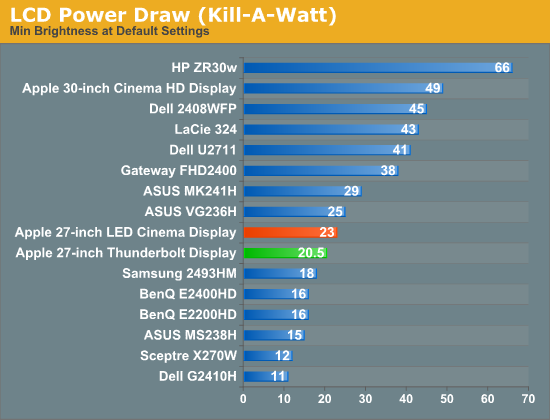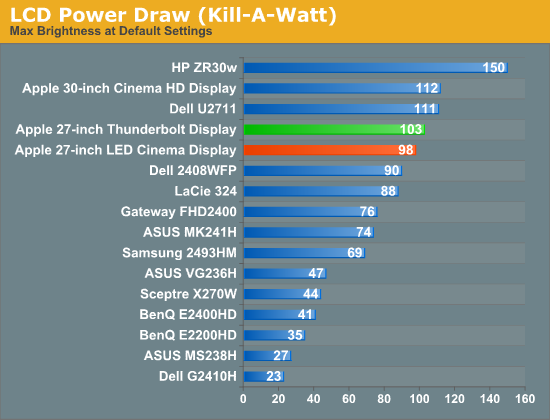The Apple Thunderbolt Display Review
by Anand Lal Shimpi on September 23, 2011 2:56 AM EST- Posted in
- Displays
- Mac
- Apple
- Thunderbolt
- Thunderbolt Display
Power Consumption
Unsurprisingly, power consumption hasn't changed much in the past year. The Thunderbolt Display draws a bit less at its dimmest setting (likely just panel efficiency variance) and draws a bit more at max brightness:


While powering a 15-inch MacBook Pro and reading data from an attached Pegasus R6 (copying to a local SSD at around 200MB/s) I measured total power consumption for the display (max brightness) at 179.6W. That number could go up if the battery in the MBP was near empty and thus being charged at a higher rate.










275 Comments
View All Comments
Ryan Smith - Friday, September 23, 2011 - link
We replaced the video a couple of hours ago with one that has better audio. You shouldn't be seeing any links to the old one (and if you are, please say where).KPOM - Friday, September 23, 2011 - link
Are there any technical reasons for using Eagle Ridge in the Thunderbolt Display instead of Light Ridge, or is it just Apple being Apple? Had they used the latter, it would have been possible to daisy chain a Cinema Display directly to the Thunderbolt Display, right?Also, on page 8, there is a slight error. You say "The MacBook Air is a different story. Not only does it only support two displays, but the Light Ridge controller only has a single DisplayPort input so you're not driving more than one external display via a MBA no matter what you do."
I think you meant to say "Eagle Ridge" controller.
-=Hulk=- - Friday, September 23, 2011 - link
Why does Intel doesn't use the daisy chaining feature of DisplayPort 1.2 instead of encapsulating individual DP v1.1 streams???Ryan Smith - Friday, September 23, 2011 - link
If I had to go out on a limb, a single TB channel doesn't have enough bandwidth for DP 1.2.Trefugl - Friday, September 23, 2011 - link
I really really love the features that thunderbolt adds to the MBAs (e.g. FireWire and GigE), but I don't want to have to upgrade my entire monitor every time I want to upgrade to the next hub (for maybe USB3 support, or more ports, etc). This would only get worse if they started to put GPUs into the monitor, as GPU tech becomes significantly outdated every year or two, whereas a good monitor can last you 5+ years. Why can't they just release a sleek HUB that you can have sitting behind your monitor. Their approach just doesn't make sense if you already have a 27" or 30" monitor (nor for future upgrades).slashbinslashbash - Friday, September 23, 2011 - link
If you already have a 27" or 30" monitor, then yes, this doesn't make as much sense. If you are just now buying such a monitor, then the Thunderbolt Display makes perfect sense. There is nothing keeping you from buying a future box/hub that you describe, and using it between the MBA/MBP and the display (if the box/hub has a built-in GPU) or daisy-chaining it after the display (if you just want USB3 or other ports). That's the great thing about Thunderbolt, you can keep adding on to it. This display is not necessarily the final link in the chain, nor is it necessarily the first link in the chain. It provides useful functionality at a competitive price today, and the add-on capabilities of Thunderbolt will continue to be useful as new tech comes on line.Trefugl - Friday, September 23, 2011 - link
But what happens when the "next cool thing" comes out that we want in our monitors? Do you just replace a perfectly good monitor because you want to upgrade the addons? I suppose my feelings towards this stem more from the iMac, where you trash a good monitor every few years because you want a new all in one PC...slashbinslashbash - Friday, September 23, 2011 - link
Nobody trashes their old iMacs. The secondary market for Macs is huge. It's not like the PC world where your 3-year-old CPU and mobo would go for $100 so you just keep them as backup or put them into a machine for folding or something. With iMacs, if you upgrade at 3 years then you can probably still get around 40-50% of what you paid for it. 2008 iMacs are regularly going for $600+ on eBay. You buy a new one, transfer everything over, and sell the old one. It's almost like buying a car where you 'trade in' your old model.HMTK - Friday, September 23, 2011 - link
This must be a US phenomenon then.jecs - Friday, September 23, 2011 - link
Well, not a US exclusive or phenomenon.It happens worlwide because most Mac laptops or Pro Macs have been traditionally decent machines (not the best or the most specialized but sure not the cheapest). Some people like OSX but doesn't want to expend on new hardware.
And not a phenomenon because this is not exclusive to Macs but to many decent products that age well including speakers, cars, movies or albums and many more things.